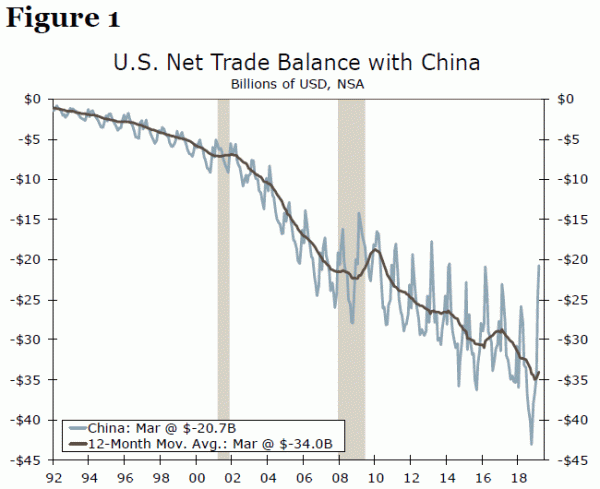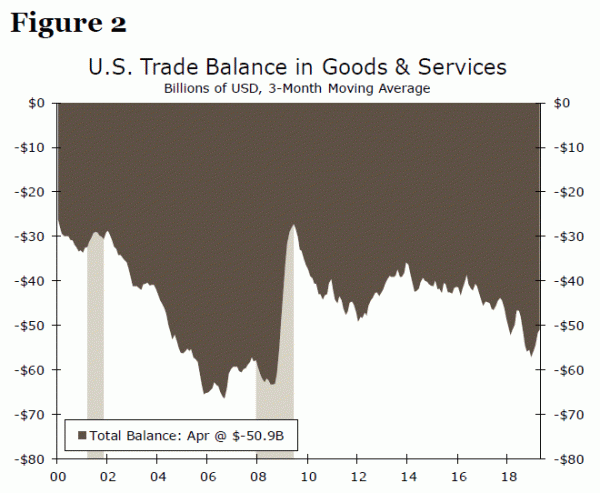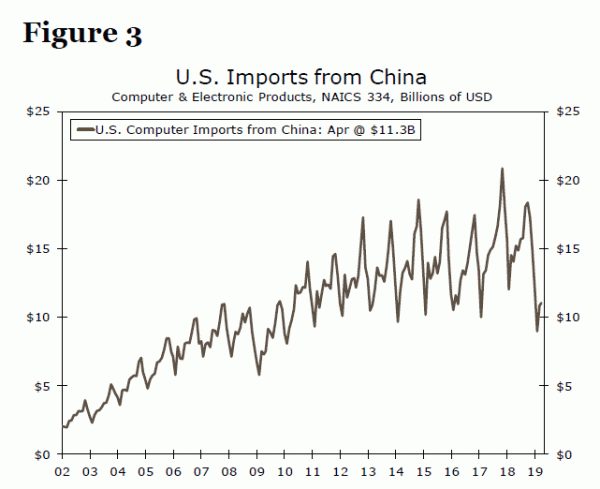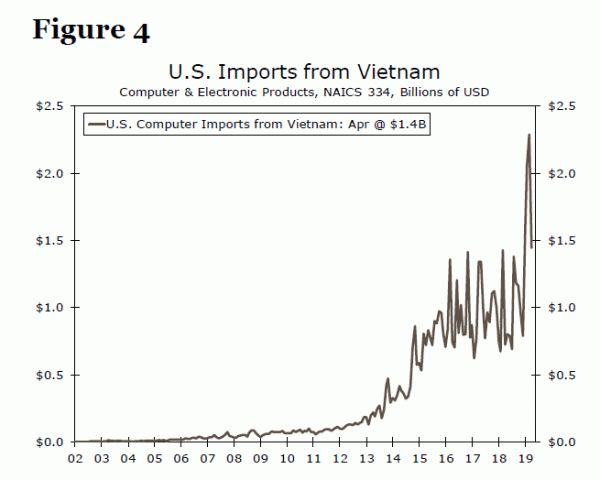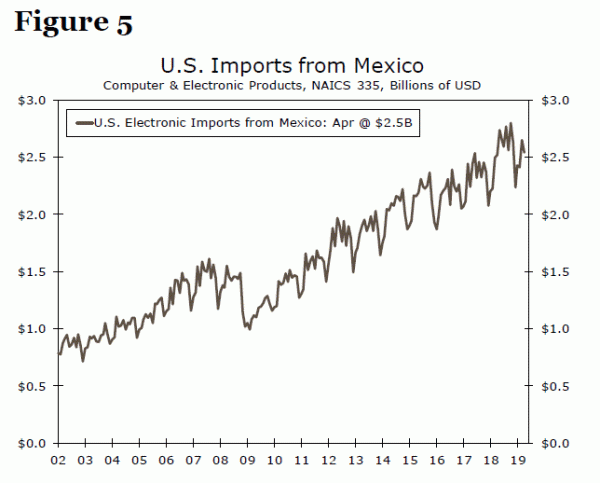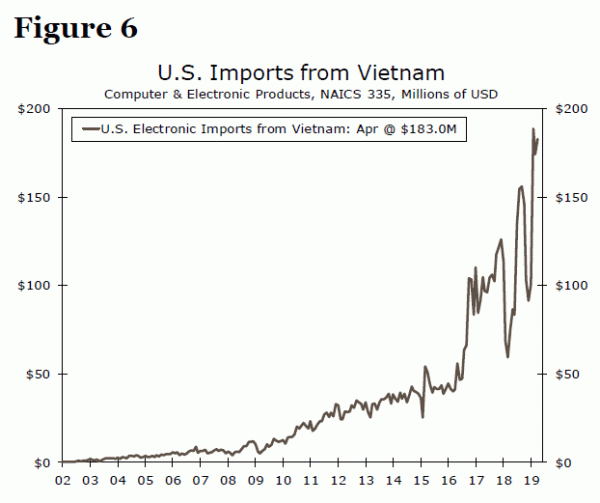Who Gains From China’s Pain? Mostly Vietnam, Mexico and Eurozone
Tariffs have reduced imports into the United States from China and reversed (at least temporarily) a decades-long expansion of the U.S. trade deficit with that country (Figure 1). Yet the trade war has not reduced total imports nor has it made a dent in the overall trade deficit (Figure 2). In fact, since the start of 2017, the trade deficit has widened 16.8%. Perhaps eventually production will shift back to the United States, but so far, there is not much evidence to support that supposition.1 Instead, domestic importers are re-routing foreign supply chains. In this special report we look at how this global shift has impacted U.S. trade and which economies have benefitted. It is early days yet, but not too early to glean insights from what the data are telling us about who is benefiting from the trade war. The winners vary by industry, but the key benefactors appear to be Vietnam, Mexico and the Eurozone.
How Do You Measure Something Like That?
The first step in our analysis is to identify the largest categories of imports from China, to capture a snapshot prior to the trade war. The tariffs on $200 billion of various Chinese goods went into effect in September 2018, although steel and aluminum tariffs went into effect in June of last year and other tariffs impacting China (on solar panels and washing machines) date back to the start of 2018. On that basis, we selected 2017, the year prior to the introduction of the various tariffs.
In 2017, the three biggest U.S. import categories from China were computers, electronics and machinery & other manufacturing2. Taken together, these three categories comprised 60% of all U.S. imports from China in 2017.
The next step is to look at how trade with other foreign economies changed in the first four months of this year compared to 2017.3 We analyzed U.S. trade data with the rest of the world to identify countries from which the United States sources goods of those same four categories to determine which foreign economies have benefitted the most from the imposition of tariffs on China.
How we do it: For each of the three identified import categories, we divided U.S. imports during the first four months of 2019 for every country in the world by the total U.S. imports in that category. This gives us a “global share of U.S. imports” for each country. We then compare that global share of imports for the first four months of 2019 to the comparable share from 2017. By subtracting the 2017 share from the 2019 share, we are able to identify which foreign economies have seen the most growth in its respective share of imports for that category.
R2-D2, You Know Better than to Trust a Strange Computer
No category is more essential in the U.S. trade relationship with China than computer and peripheral equipment. In 2017, this category alone accounted for more than a third of all imports from China. But further, look at imports from China as a share of the total U.S. imports in this category and we see that China is America’s most vital import source providing 46% of all imports and comprising (by far) the largest share of imports globally for computers.
Even in the face of tariffs and the well-publicized battle with Chinese company Huawei, a maker of diversified technology and consumer electronics products, China remains the top foreign source for this category. That said, the share has fallen to just 35.8% through the first four months of 2019.
So while China’s role as a foreign source of computer products is still significant, it is clearly wilting under the pressure of tariffs. So as supply chains shift, what foreign economies are taking up the slack?
Vietnam more than doubled its share of U.S. computer imports to 6.2% share in the first four months of 2019 from a 2.9% share in 2017. The doubling of exports overnight has been met with skepticism and doubts about the authenticity of Vietnam as the genuine, bonafide manufacturer of all of these new imports. The net increase of 3.2 percentage points was the largest pick-up of any country. Taiwan, a global leader in semiconductors, saw the second largest share increase, adding 2.1 percentage points to its proportion of computer-related U.S. imports.
Mexico, South Korea and the Eurozone rounded out the top five economies that have picked up the slack as China’s share of U.S. computer imports has shrunk.
Electrical Products: 220, 221…Whatever It Takes
The category of electrical products includes a number of consumer durable goods categories like washers, dryers and refrigerators as well as smaller household appliances. This is the second largest category that China supplied to the United States in 2017. However, by virtue of the fact that this category includes washing machines, it was subject to tariffs in January 2018, eight months earlier than the broader basket of Chinese goods that went into effect in September 2018. So at least a portion of this category has some more history of being subject to the tariffs.
When we look at how importers are shifting supply chains for this category, we find that Mexico is the largest beneficiary. That said, even before the tariffs went into effect, Mexico was already the second largest foreign supplier of electronic equipment to the United States. The tariffs may have helped cement Mexico’s role as a U.S. supplier of electronic products even though it has seen trend improvement for the past decade (Figure 5). For more of a “pure-play” tariff substitution, Vietnam offers another eyebrow-raising spike in shipments of electronic equipment destined for the United States (Figure 6). The Eurozone, Malaysia and Thailand have also all seen an increase in their share of U.S. imports of electronics.
Industrial Evolution
Our third and final category combines miscellaneous manufacturing with the much larger equipment manufacturing. This category include agricultural equipment, general-purpose machinery, lawn and garden equipment, HVAC components and construction equipment among many other categories. As China’s share of the U.S. equipment market has been cut amid the ongoing trade war, where has America turned to make up the shortfall?
Japan has long been a key import partner in this category and the island nation has seen its share increase to 9.8% in the first four months of 2019 from 9.0% of U.S. machinery manufacturing imports; that is enough to take the top spot in terms of largest growth since 2017. Mexico and the Eurozone are tied for second in terms of growth in the share of U.S. machinery imports. Machinery imports from Mexico and Japan are about the same size; both have roughly a 10% share of overall U.S. machinery imports. The Eurozone supplies about as much as both Mexico and Japan combined; 21.3% in the first four months of 2019. China’s share for the same period was 22.2% and falling fast from the 26.3% share it commanded back in 2017. Without a quick resolution to the trade war, it is likely that the Eurozone will displace China as the largest foreign source for U.S. machinery imports.
Conclusion
When China joined the World Trade Organization in 2001, the U.S. trade deficit with China was about $83 billion. That deficit ballooned to more than four and-a-half times that amount over the 16 years to $375 billion in 2017. The tariffs imposed on Chinese imports have turned that trend around as the United States has imported less from China in the first four months of this year.
But the United States is not importing less overall. In fact, since the start of 2017, the trade deficit has widened 16.8%. With no demonstrable evidence that U.S. domestic production is making up for the drop-off in Chinese goods imports, the trade data tell us where U.S. importers are turning.
The winners vary by industry as we have endeavored to describe in this report, but the key benefactors are Vietnam, Mexico and the Eurozone. Whether or not the overnight shift to Vietnam for a number of key categories is a genuine transition or just a shell game is beyond the scope of this report. Perhaps the larger point here however is rather than spurring domestic production, the tariffs are instead shifting global supply chains to other foreign trading partners.
1 We analyzed U.S. domestic production by NAICS code for the four industries in our analysis, which together comprise 60% of Chinese imports. None of these categories have yet demonstrated a discernable departure from trend-growth since the implementation of tariffs.
2 For categories we are using North American Industry Classification codes, specifically: (334) computer & peripheral equipment manufacturing, which we call “computers”, (335) electrical equipment, appliance, & component manufacturing, which we call “electronics.” We combine (339) miscellaneous manufacturing and (333) machinery manufacturing and for the purposes of this report refer to both as simply “machinery & other manufacturing”. Note: the category (315) apparel would be in the top five, but we left it out as the tariffs do not yet apply to apparel from China.
3 In the absence of readily available seasonally adjusted data, we compare the first four months of 2019 to full-year 2017 on a non-seasonally adjusted basis. In reviewing the prior year’s data, share allocations for the first four months are indicative of full-year trends.




